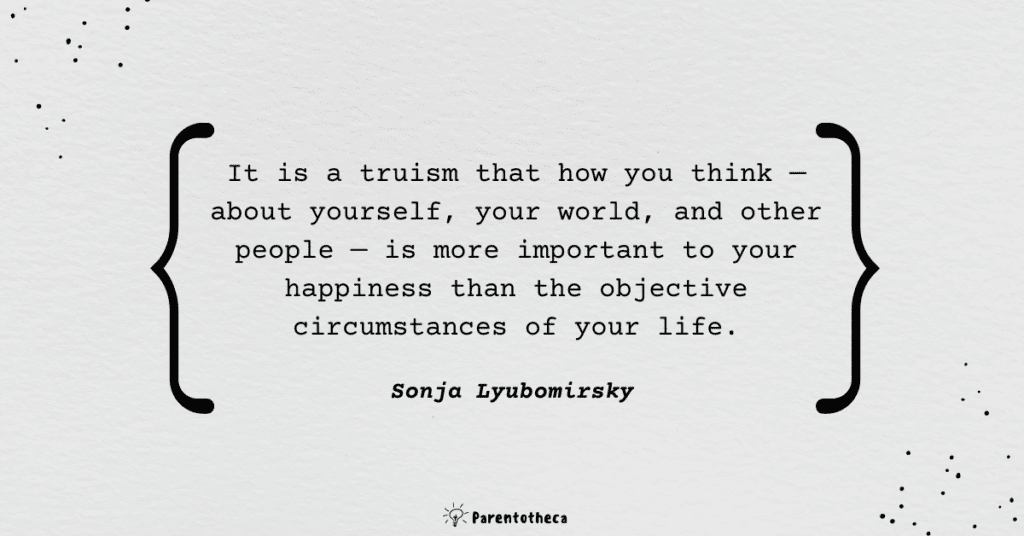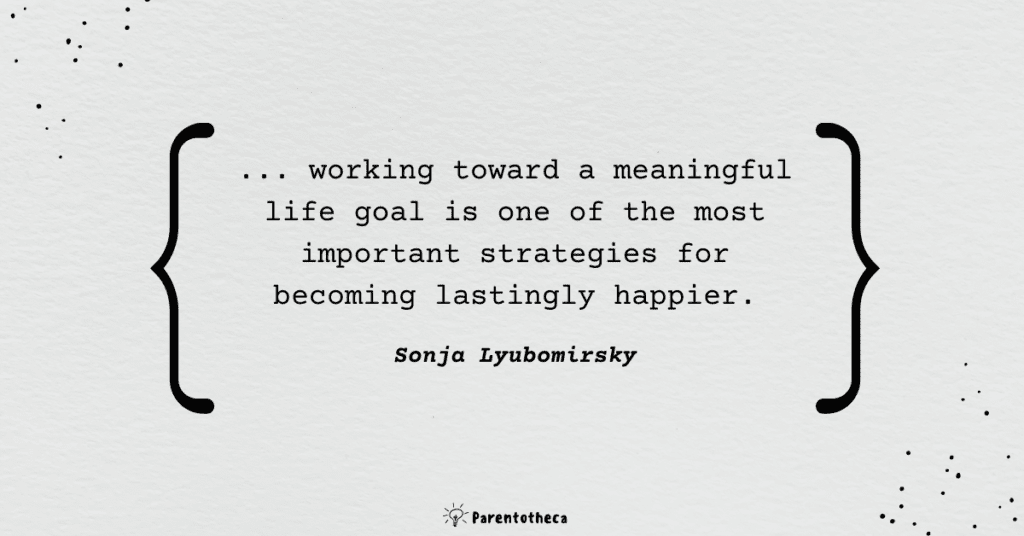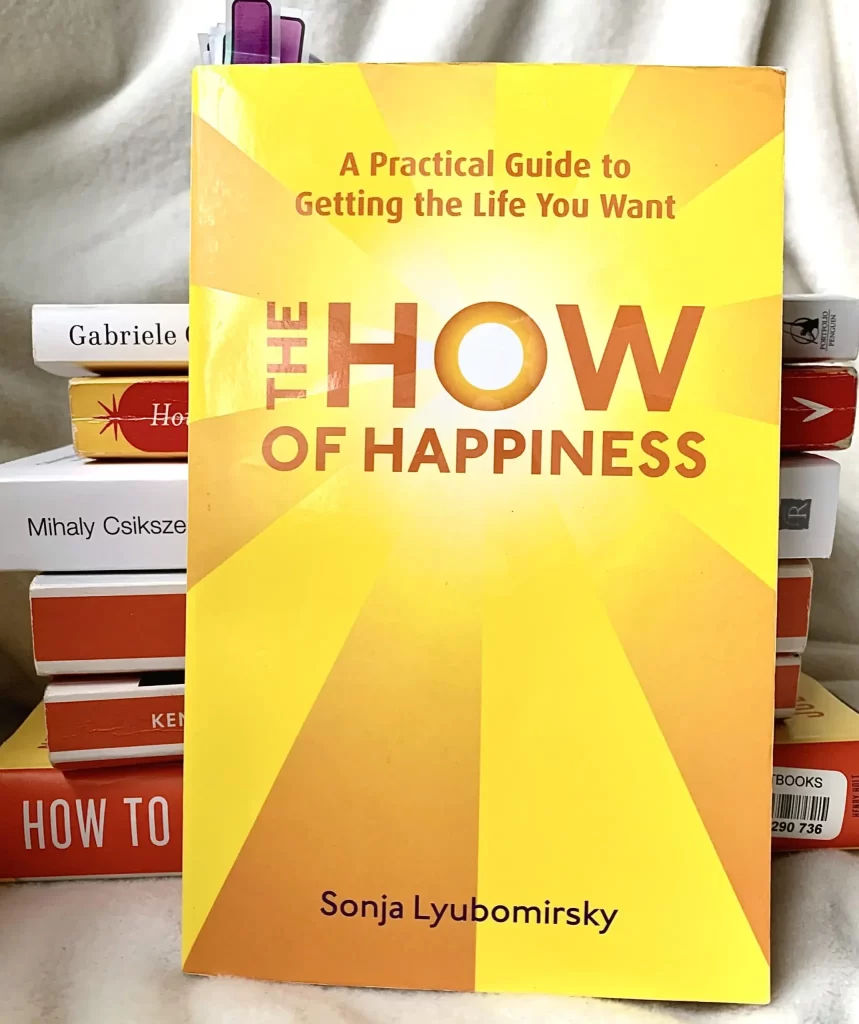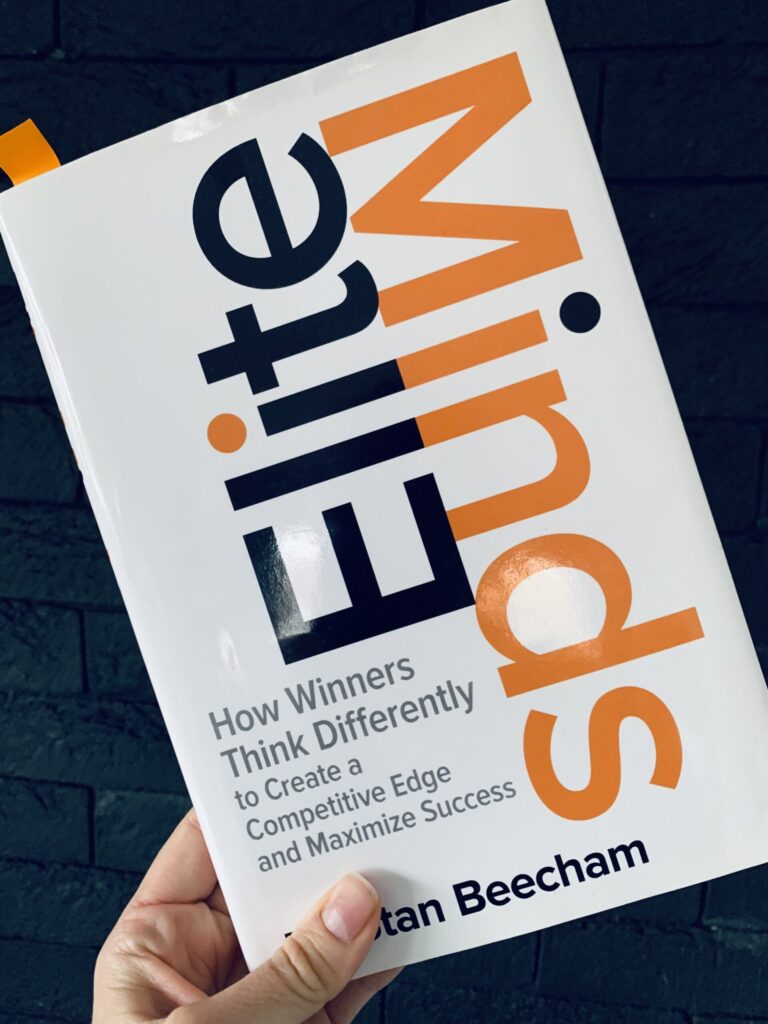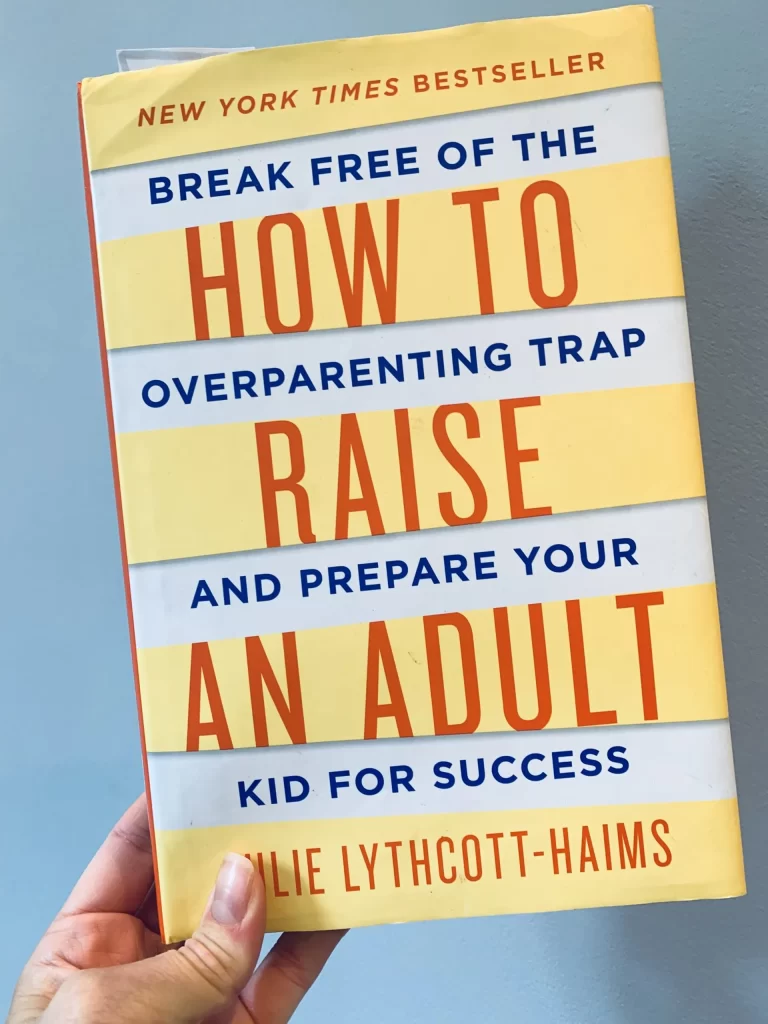 The How Of Happiness: a practical guide to getting the life you want – book summary
The How Of Happiness: a practical guide to getting the life you want – book summary
Sonja Lyubomirsky
Piatkus (4 Feb. 2010)
About the author:
Sonja Lyubomirsky is Professor of Psychology at the University of California, Riverside. Originally from Russia, she received her A.B., summa cum laude, from Harvard University and her PhD in Social/Personality Psychology from Stanford University. Her research has been honoured with the Diener Award for Outstanding Midcareer Contributions in Personality Psychology, the UC Riverside Distinguished Research Lecturer Award, a Templeton Positive Psychology Prize, a Science of Generosity grant, two John Templeton Foundation grants, a Character Lab grant, A Psychology & Philosophy grant, and a million-dollar grant (with Ken Sheldon) from the National Institute of Mental Health to research the possibility of permanently increasing happiness.
About the book:
For the last 20 years, professor Sonja Lyubomirsky has been testing various ways to increase our happiness level. This book summarises her years of research in the positive psychology field, and it is packed with proven strategies for boosting your level of happiness at home, at work and your professional life. This book is absolutely packed with fantastic ideas, and we would highly recommend to read it if you are serious about living a truly happy life.
Key ideas from the book:
“The majority of people in the world, across vast continents and cultures, profess that being happy is one of their most cherished goals in life – for themselves and, above all, for their children. What’s more, happiness offers myriad rewards – not just for the happy person, but for his or her family, workplace, community, nation and society. Working on how to become happier, the research suggests, will not only make a person feel better, it will boost his or her energy, creativity and immune system, foster better relationships, fuel higher productivity at work and even lead to a longer life.”
These are good enough reasons why to be happy! Let’s dive into the few practical and science-based tips on how to become lastingly happier.
The 40% solution – we should focus on our behaviour and mindset to become happier:
“In a nutshell, the fountain of happiness can be found in how you behave, what you think, and what goals you set every day of your life. ‘There is no happiness without action.’ If feelings of passivity and futility overcome you whenever you face up to your happiness set point or to your circumstances, you must know that a genuine and abiding happiness is indeed within your reach, lying within the 40 percent of the happiness pie chart that’s yours to guide.”
Through fascinating studies with identical twins separated at birth, scientists have concluded that our genetic makeup determines about 50% of our happiness. So we all have a “happiness set-point”—a level of happiness we tend to gravitate toward. That means that about 50% is fixed, and basically, we can’t do anything about it.
Now, our life circumstances determine 10% of our happiness level. The majority of people spend all their time and energy on this variable, but science says that increasing our wealth, attractiveness and stuff like that has both a relatively minor and a temporary impact on our wellbeing.
The rest 40%, our behaviour and mindset, is what we should focus on:
“What makes up this 40 percent? Besides our genes and the situations that we confront, there is one critical thing left: our behavior. Thus the key to happiness lies not in changing our genetic makeup (which is impossible) and not in changing our circumstances (i.e., seeking wealth or attractiveness or better colleagues, which is usually impractical), but in our daily intentional activities. With this in mind, our pie chart illustrates the potential of the 40 percent that is within our ability to control, the 40 percent for room to maneuver, for opportunities to increase or decrease our happiness levels through what we do in our daily lives and how we think.”
This 40% is what happiness is about. And that is totally in our control.
“Happiness is not a destination, it is a way of life”:
If you want to live a happy life, you have to work on it – that’s all about effort and consistency:
“It may be obvious that to achieve anything substantial in life—learn a profession, master a sport, raise a child—a good deal of effort is required. But many of us find it difficult to apply the notion of effort to our emotional or mental lives. Without effort, we might ‘get lucky,’ but like a long-forgotten New Year’s resolution, the success will be short-lived. Consider how much time and commitment many people devote to physical exercise, whether it’s going to the gym, jogging, kickboxing, or yoga. My research reveals that if you desire greater happiness, you need to go about it in a similar way. In other words, becoming lastingly happier demands making some permanent changes that require effort and commitment every day of your life. Pursuing happiness takes work, but consider that this ‘happiness work’ may be the most rewarding work you’ll ever do.”
So roll your sleeves up and work on your happiness 🙂
12 happiness activities:
In the second part of the book, Sonja describes 12 Happiness Activities that have been scientifically proven to increase our happiness levels. In a nutshell, here they are:
- Expressing Gratitude
- Cultivating Optimism
- Avoiding Overthinking and Social Comparison
- Practicing Acts of Kindness
- Nurturing Social Relationships
- Developing Strategies for Coping
- Learning to Forgive
- Increasing Flow Experiences
- Savoring Life’s Joys
- Committing to Your Goals
- Practicing Religion and Spirituality
- Taking Care of Your Body: Meditation + Physical Activity + Acting Like a Happy Person
One of Sonja’s key points is that we don’t have to do ALL of these activities to increase our happiness level, but should choose those activities that inspire us and bring us more joy.
The book is literally packed with the research on each activity, so please read the book for more inspiration. Below we’ll share our favourite ideas.
Expressing gratitude:
“People who are consistently grateful have been found to be relatively happier, more energetic, and more hopeful and to report experiencing more frequent positive emotions. They also tend to be more helpful and empathic, more spiritual and religious, more forgiving, and less materialistic than others who are less predisposed to gratefulness. Furthermore, the more a person is inclined to gratitude, the less likely he or she is to be depressed, anxious, lonely, envious, or neurotic.”
In the book, Sonja talks about the research showing that people who kept a weekly gratitude journal for ten weeks in which they noted five things for which they were thankful were significantly happier than those who didn’t.
How to express gratitude? Journaling, meditation, through art, directly to other person (phone, conversation, letter, email) – whatever suits you 🙂 Question for you for now – what are the five things you are grateful for today?
Practice optimism – “best possible selves diary”:
Optimism is huge in positive psychology, and it’s proven to boost your happiness. Building optimism is not only about anticipating a bright future, but also about exactly how you would achieve this future.
One of the scientifically proven strategies to cultivate optimism is the “Best possible selves” diary method:
“To try it out, sit in a quiet place, and take twenty to thirty minutes to think about what you expect your life to be one, five, or ten years from now. Visualize a future for yourself in which everything has turned out the way you’ve wanted. You have tried your best, worked hard, and achieved all your goals. Now write down what you imagine. This writing exercise in a sense puts your optimistic ‘muscles’ into practice. Even if thinking about the brightest future for yourself doesn’t come naturally at first, it may get there with time and training. Amazing things can come about as a result of writing.”
So once you have your big goals and dreams in writing, you can follow up this exercise with making a clear plan on how to achieve these big goals – break down each big goal into sub-goals. And rock it!
Overthinking, social comparison and happiness:
Want to become happier – take control over overthinking and ruminating about the problem: “if you are an overthinker, one of the secrets to your happiness is the ability to allay obsessive overthinking and to reinterpret and redirect your negative thoughts into more neutral or optimistic ones”. So don’t let yourself to get into “the Maze”.
The worst-case scenario is ruminating while having a bad mood – research shows that this would make you feel even worse:
“The combination of rumination and negative mood is toxic. Research shows that people who ruminate while sad or distraught are likely to feel besieged, powerless, self-critical, pessimistic, and generally negatively biased.”
At the same time, want to be happy – stop comparing yourself to others:
“People who pay too much attention to social comparisons find themselves chronically vulnerable, threatened, and insecure.”
And remember: “The happier the person, the less attention she pays to how others around her are doing.”
Strategies for avoiding overthinking and social comparison? Distract yourself from negative thought (simply by saying “Stop” when you catch yourself on negative thoughts). And our favourite one – if you have a problem, take actions to solve it instead of ruminating on it.
Learn how to manage stress – develop coping strategies
“We deem those happy who from the experience of life have learned to bear its ills, without being overcome by them”
Juvenal
Our lives are all about ups and downs. Bad things do happen, and they may significantly affect our mental wellbeing and health in general. But happy people know how to cope with these situations.
The science outline two key coping strategies – problem-focused and emotional-focused coping. Both are super-efficient when we face stressful situations (from minor stress to real tragedies in our lives). Sonja offers to grab a notebook and use one of the three practical strategies when facing hardship and stress:
- Finding meaning through “expressive writing” – write about your most traumatic experience in life. Put your deepest thoughts and feelings on paper. Just let it go. Write for four days in a row (or more if needed) for a minimum of 15 minutes each day and watch the benefits unfold.
- Construing benefit in trauma through writing or conversing – this is also a writing exercise (could be followed by a conversation) and its main goal is to find benefit in pain. Three key steps here: firstly, “acknowledge that your loss or trauma has caused you a great deal of pain and suffering. Then, consider what have you done during your loss or in response to it that you are proud of.” Next step is to think about how much you have grown as a result of your loss. And finally, think about how the trauma/loss has positively affected your relationship with your close people.
- Coping via thought disputation – this strategy helps to cope with negative emotions and beliefs resulting from a stressful experience. Write about ABCDE: A – write down the nature of adversity, B – outline negative beliefs you are facing, C – think about the consequences of the problem, D – dispute the negative belief, challenge it, think about all other possible reasons of the problem; E – think about the more optimistic explanation of the problem which can energise you and lift your spirits.
Commit to your life goals
Science says that following your goals and dreams is crucial for your happiness. Apparently, we all have some goals. But happy people choose goals, which are intrinsic, authentic, harmonious, involve approaching a desirable outcome, and at the same time, are flexible and appropriate. Research also says that if we pursue an activity goal (joining dance classes, learning a new language, etc), we are more likely to boost our happiness level.
What is really important is that happy people also own their goals and stay committed to them with passion.
So question for you – what are your most important goals in life? Do you own them?
Exercise to be happy:
“An impressive study of physical activity was published in the Archives of Internal Medicine in 1999. The researchers recruited men and women fifty years old and over, all of them suffering from clinical depression, and divided them randomly into three groups. The first group was assigned to four months of aerobic exercise, the second group to four months of antidepressant medication (Zoloft), and the third group to both. The assigned exercise involved three supervised forty-five-minute sessions per week of cycling or walking/jogging at moderate to high intensity. Remarkably, by the end of the four-month intervention period, all three groups had experienced their depressions lift and reported fewer dysfunctional attitudes and increased happiness and self-esteem. Aerobic exercise was just as effective at treating depression as was Zoloft, or as a combination of exercise and Zoloft. Yet exercise is a lot less expensive, usually with no side effects apart from soreness. Perhaps even more remarkably, six months later, participants who had “remitted” (recovered) from their depressions were less likely to relapse if they had been in the exercise group (six months ago!) than if they had been in the medication group.”
Feeling low or unhappy – get yourself moving! Fascinating stuff 🙂
Action steps for you:
- Which Happiness Activity would you practice today?
- Maybe you can consider getting a notebook for journalling?
- What are your most important goals in life? Write them down and make a plan to achieve them.
Favourite quotes from the book:
